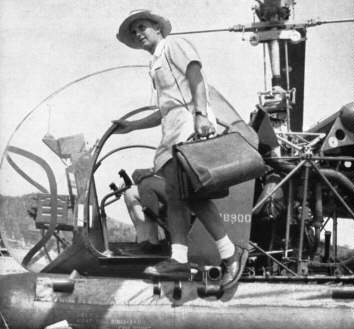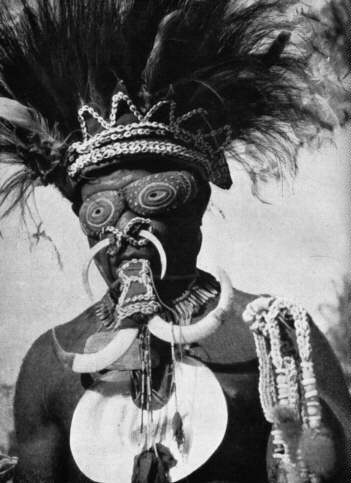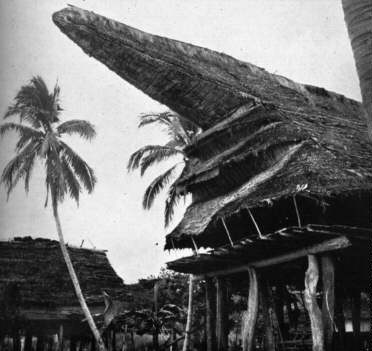
|
|
| Cannibal Culture | |
|
Selected excerpts from Jens Bjerre’s The Last Cannibals on primitive beliefs and customs New Guinea |
The Vailala Madness
We discussed the habits and beliefs of the natives. ‘We never get to know them completely,’ said Freddy. ‘Look at our friends here in Kambot, where life goes on peacefully and harmoniously. Yet even after long and friendly contact with Europeans, a sort of primitive volcanic eruption can break out among the natives. Only a few years ago forty of them lost their heads in the Ambunti district a little further up the river. They were attacked by another tribe who had an old account to settle. All had seemed peaceful enough in the district – yet suddenly this massacre was committed. A few years ago these people were head-hunters. They are not any more. Their old habits and ceremonies are slowly disappearing – and leaving a dangerous vacuum. When you take something away from these people you ought to replace it. But how? You cannot just give them a ready-made religion to follow. We understand very little of their psychology, which is so very different from ours.
‘A few years ago we saw this vacuum in operation. A sort of holy war broke out among the natives, a mass hysteria which spread like wild-fire through great areas of New Guinea. The movement was directed against the Europeans, and if it hadn’t been checked in time would have had bloody results. As it was there were many ugly incidents. The significant thing about it was that it flared up not among the primitive natives of the jungle, but among the natives around the plantations and mission stations, and it only affected tribes in contact with Europeans. Most of the natives around here were in contact with the mission station and had heard sermons about Christianity. But you can’t suddenly change a people’s mentality. The natives tried, more or less, to adapt their beliefs to the new Christian doctrines and drew some queer conclusions in the attempt. When told that we rise from the dead, and that in Heaven all are equal, the natives inferred that all who died would be born again – with a white skin. And from then on they believed that all white people were reincarnated natives: in other words their forefathers returned in a new guise. What is more, they were now persuaded that all the white people’s goods were really presents the spirits in Heaven had entrusted to the whites to deliver to the natives. The whites had stolen these goods, and were holding them in warehouses and shops and forcing the natives to work and pay for the goods that were rightly theirs already!
‘They wanted these goods, and as they couldn’t see any direct way of getting at them, they turned towards their traditional superstitions. By the help of magic rites they would implore their forefathers’ spirits in Heaven to send the goods to them direct by ship or plane. The more they talked about it, the more they persuaded themselves that this was how it could be made to happen! They gradually worked themselves up to a frenzy of grievance, and the movement spread to other villages along the coast. Some places they laid a “welcome” table ready for the forefathers’ spirits to come along with all the goods they wanted. It was a white man’s table they laid; with white tablecloth, tin plates and white man’s dishes.

‘The rumour spread that a big ship was on the way to them from the spirits in Heaven, fully loaded with tobacco, cloth, preserves, electric torches, knives, axes; and with rifles and ammunition too, it was said later. The weapons were to drive the whites out of the country, so that they couldn’t steal any more of the goods that were intended for the people. Some dark night or other the natives would imagine they saw a ship nearing the village from the sea. They would run out of their huts, swing burning torches and shout and scream in hysterical excitement. They completely lost their mental balance and these fevers of hysteria could last for several weeks, even months. The whole rhythm of the daily life of the village was disturbed, the fields went untended (for now it was not necessary to work in them any more, far all they needed was on the way). In some places they even started to build large huts to store the goods when the ship arrived. In the huts they put stones, sticks and piles of leaves as symbols of the guns and goods they expected.
‘The oddest thing was that this madness in many cases resulted in hysterical attacks of cramp. When they were seized by their delusions, their bodies would shiver, they swung their arms violently about and shook their heads madly, finally falling down and writhing in pain while the froth poured from their mouths. Some got the “gift of tongues” and shouted a lot of gibberish, which no one could understand. It was believed that the spirits were talking.
‘This delirium was contagious. If one man was taken with cramps, the whole village would soon have them, too. Some of them took up fantastic postures, others improvised crazy dances and songs, the latter being sometimes a corruption of the hymns they had learned at the mission schools. Even peaceful mission boys, who the missionaries thought were quite Christian, ran amok in this way.’

When Freddy told me these things, I recalled an odd experience I had had when I lived with Barry Osborne in Nondugl. Once we were awakened at two o’clock in the morning by an excited boss-boy, who knocked on the bedroom door and told Barry some confused nonsense, which I didn’t quite catch in my sleepy state. But I wakened quickly enough when I saw Barry jump out of bed, put on his trousers and run out into the dark. I hurried after him and the boss-boy over to the boys’ huts. Here all was wild confusion. Four of the boys were trying to hold down a boy who kicked and shouted wildly, his lips frothing, his eyes wild and empty. We tied him up, and Barry gave him a sedative injection. Barry called it momentary madness, and said, that it was not unusual for some of the natives at the post to get such an attack. The next day the boy was kept in bed and was given one more injection, but on the third day he was working normally.
Freddy continued, while the rain drummed on the roof: ‘To start with none of the Europeans were aware of what was going on inside the heads of the confused natives, but it gradually dawned on them that something was very wrong. The plantation owners along the coast, where the movement spread most, felt their lives threatened, and the authorities at Port Moresby intervened. The worst fanatics were removed and the “warehouses”, that were waiting for the goods, were burned.’
The Vailala madness, as it is called, is under control on the Papua coast, but it had spread like a wave over New Guinea and up to a few years ago it would break out here and there, in the Highlands as well as among the tribes on the north coast. In some places it developed into tragedies. At one place on the north coast, near Bogia, the natives burned down their own huts, ruined their fields, slaughtered their pigs and sat for several days on the beach waiting for the ship with their forefathers’ spirits to arrive with food for them. The movement took various forms in different places according to what the natives could imagine and according to the rumours they heard. The authorities did not call it Vailala madness any more, but the cargo-cult: it was always about cargoes from Heaven.
Jens Bjerre, The Last Cannibals, Michael Joseph, 1956 pp. 179-182